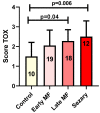TOX Expression in Mycosis Fungoides and Sezary Syndrome
- PMID: 35885488
- PMCID: PMC9316398
- DOI: 10.3390/diagnostics12071582
TOX Expression in Mycosis Fungoides and Sezary Syndrome
Abstract
Mycosis fungoides (MF) and Sezary syndrome (SS) are the two most common type of cutaneous T-cell lymphoma (CTCL). Currently, no markers can be clearly related to prognosis or to differential diagnosis between early stages and inflammatory benign diseases (IBD). The thymocyte selection-associated high mobility group box factor (TOX), has been proposed as a possible marker in differential diagnosis between early CTCL stages and IBD. Recently TOX has been related to prognosis. We aimed to investigate whether TOX may be a diagnostic or prognostic marker. MF and SS biopsies between 2010 and 2020 were retrieved. New tissues slides were stained with an anti-TOX antibody, (Clone NAN448B). On each slide, 5 fields were examined at high magnification (400×), to evaluate the percentage of marker-positivity in a quantitative way. Thirty-six patients (12 females and 24 males) and 48 biopsies were collected. Nine patients had multiple biopsies. TOX expression in MF/SS cases showed an increase from early to advanced phases. TOX was not regarded as a prognostic marker due to the absence of significant changes by comparing early MF cases with reactive conditions. TOX statistical significance increased in patients alive with disease and in those dead of disease (p = 0.013 and = 0.0005, respectively) as compared with patients in complete remission. Our results show that TOX should be regarded more as a prognostic than a diagnostic marker.
Keywords: Sezary syndrome; TOX; mycosis fungoides.
Conflict of interest statement
The authors declare no conflict of interest.
Figures







Similar articles
-
TOX expression in cutaneous T-cell lymphomas: an adjunctive diagnostic marker that is not tumour specific and not restricted to the CD4(+) CD8(-) phenotype.Br J Dermatol. 2016 Aug;175(2):382-6. doi: 10.1111/bjd.14508. Epub 2016 Jun 29. Br J Dermatol. 2016. PMID: 26931394
-
TOX expression in different subtypes of cutaneous lymphoma.Arch Dermatol Res. 2014 Nov;306(9):843-9. doi: 10.1007/s00403-014-1501-7. Epub 2014 Sep 13. Arch Dermatol Res. 2014. PMID: 25216799
-
Primary cutaneous T-cell lymphoma (mycosis fungoides and Sézary syndrome): part I. Diagnosis: clinical and histopathologic features and new molecular and biologic markers.J Am Acad Dermatol. 2014 Feb;70(2):205.e1-16; quiz 221-2. doi: 10.1016/j.jaad.2013.07.049. J Am Acad Dermatol. 2014. PMID: 24438969 Review.
-
TOX expression and role in CTCL.J Eur Acad Dermatol Venereol. 2016 Sep;30(9):1497-502. doi: 10.1111/jdv.13651. Epub 2016 Jun 26. J Eur Acad Dermatol Venereol. 2016. PMID: 27345620 Free PMC article.
-
Primary cutaneous T-cell lymphoma (mycosis fungoides and Sézary syndrome): part II. Prognosis, management, and future directions.J Am Acad Dermatol. 2014 Feb;70(2):223.e1-17; quiz 240-2. doi: 10.1016/j.jaad.2013.08.033. J Am Acad Dermatol. 2014. PMID: 24438970 Review.
Cited by
-
Targeting TAG-72 in cutaneous T cell lymphoma.Heliyon. 2024 Aug 22;10(17):e36298. doi: 10.1016/j.heliyon.2024.e36298. eCollection 2024 Sep 15. Heliyon. 2024. PMID: 39263154 Free PMC article.
-
Molecular Insights into the Diagnosis of Anaplastic Large Cell Lymphoma: Beyond Morphology and Immunophenotype.Int J Mol Sci. 2025 Jun 19;26(12):5871. doi: 10.3390/ijms26125871. Int J Mol Sci. 2025. PMID: 40565334 Free PMC article. Review.
-
Dermatoscopic Patterns in Mycosis Fungoides: Observations from a Case-Series Retrospective Analysis and a Review of the Literature.Diagnostics (Basel). 2025 Apr 29;15(9):1136. doi: 10.3390/diagnostics15091136. Diagnostics (Basel). 2025. PMID: 40361954 Free PMC article.
References
-
- Torre-Castro J., Estrach T., Penate Y., Acebo E., Fernandez de Misa R., Blanes M., Suh-Oh H.J., Botella-Estrada R., Torrelo A., Garcia-Doval I., et al. Primary cutaneous lymphomas in children: A prospective study from the Spanish Academy of Dermatology and Venereology (AEDV) Primary Cutaneous Lymphoma Registry. Pediatr. Dermatol. 2021;38:1506–1509. doi: 10.1111/pde.14811. - DOI - PubMed
-
- Ottevanger R., de Bruin D.T., Willemze R., Jansen P.M., Bekkenk M.W., de Haas E.R.M., Horvath B., van Rossum M.M., Sanders C.J.G., Veraart J., et al. Incidence of mycosis fungoides and Sezary syndrome in the Netherlands between 2000 and 2020. Br. J. Dermatol. 2021;185:434–435. doi: 10.1111/bjd.20048. - DOI - PMC - PubMed
LinkOut - more resources
Full Text Sources
Other Literature Sources

